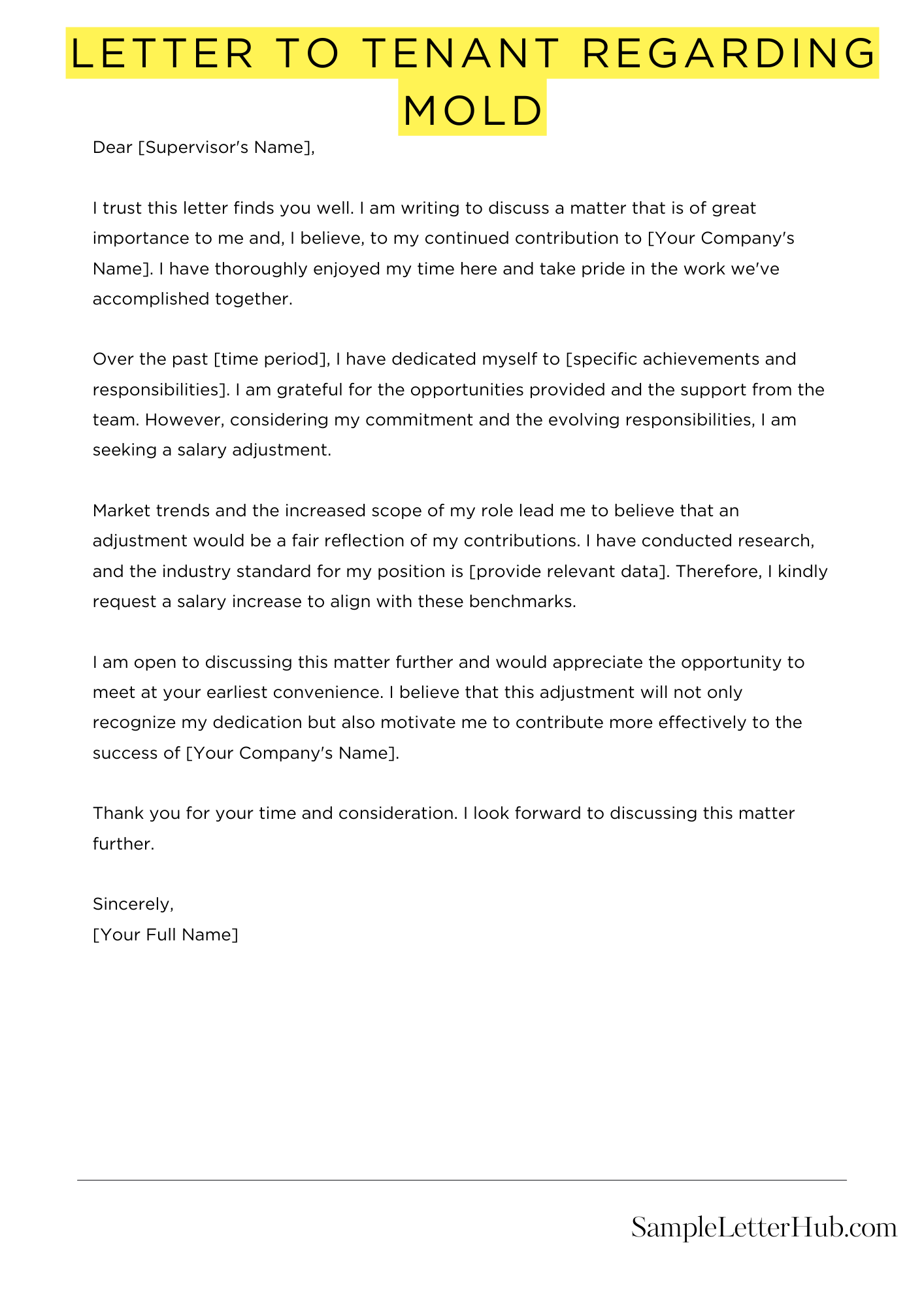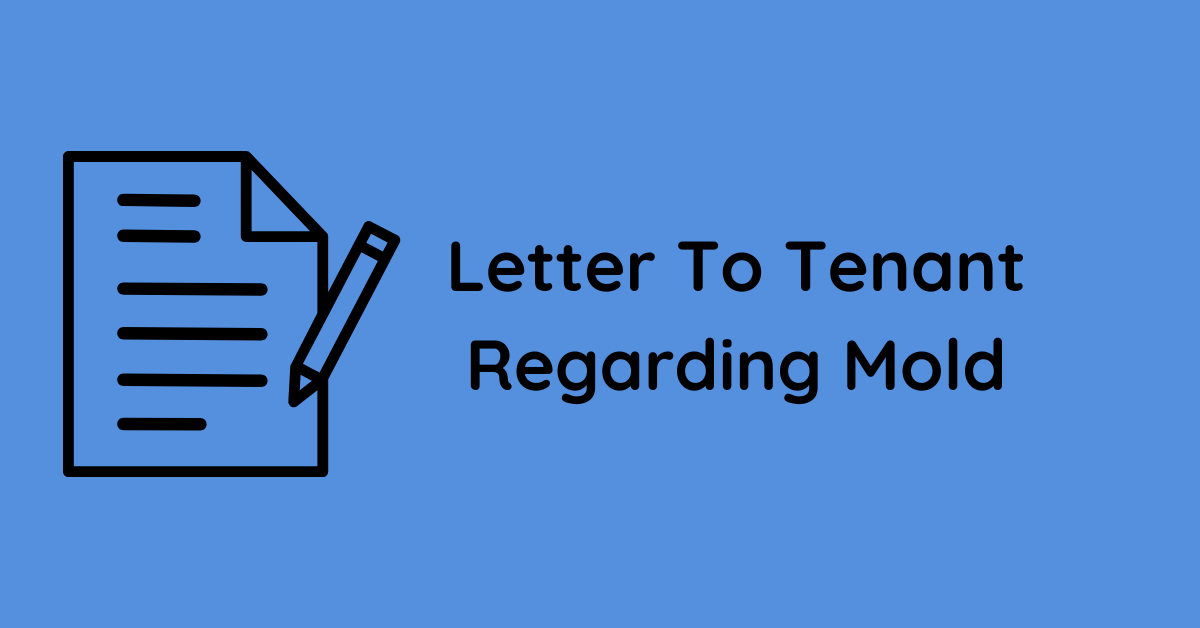A Letter To Tenant Regarding Mold is a formal communication sent by a landlord to a tenant regarding the presence of mold in the rental property. It typically outlines the issue, requests action from the tenant, and may include legal implications if the issue is not addressed promptly.
In this article, we will provide you with templates, examples, and sample letter to tenant regarding mold. These samples are designed to help you easily draft a letter that effectively communicates your concerns and requests to your tenant.
By utilizing these samples, you can save time and ensure that your letter is clear, concise, and legally compliant.
Notice to Tenant Regarding Mold
Dear [Tenant Name],
I am writing to inform you that mold has been discovered in your rental unit at [address]. I understand that this is concerning news, and I want to assure you that I am taking steps to address the issue promptly.
The mold was discovered during a routine inspection. It is located in the [area of unit where mold is located]. I have contacted a licensed mold remediation company to assess the situation and recommend the best course of action.
In the meantime, I recommend that you take the following precautions:
* Avoid spending extended periods of time in the affected area.
* Keep the area well-ventilated by opening windows and doors.
* Do not touch or disturb the mold.
* If you experience any health issues, such as respiratory problems or skin irritation, please consult a medical professional immediately.
I will keep you updated on the progress of the remediation process. I anticipate that the work will be completed within [number] days. During this time, I may need to access the unit to facilitate the remediation. I will provide you with ample notice before any scheduled visits.
I understand that this may be an inconvenience, and I appreciate your cooperation and understanding. If you have any questions or concerns, please do not hesitate to contact me.
Sincerely,
[Your Name]

How to Write a Letter to a Tenant Regarding Mold
Mold is a common problem in rental properties, and it can be a health hazard for tenants. If you’re a landlord and you discover mold in your rental property, it’s important to take action to remove it and prevent it from coming back.
1. Inspect the Property
The first step is to inspect the property to determine the extent of the mold problem. Look for mold on walls, ceilings, floors, and furniture. You should also check for any signs of water damage, such as leaks or stains.
2. Identify the Source of the Mold
Once you’ve identified the mold, you need to determine the source of the problem. Mold can be caused by a variety of factors, including:
- Water leaks
- Condensation
- Poor ventilation
- High humidity
3. Remove the Mold
Once you’ve identified the source of the mold, you can begin to remove it. There are a variety of ways to remove mold, including:
- Cleaning with a bleach solution
- Using a commercial mold remover
- Hiring a professional mold remediation company
4. Prevent the Mold from Coming Back
Once you’ve removed the mold, you need to take steps to prevent it from coming back. This includes:
- Fixing any water leaks
- Improving ventilation
- Controlling humidity
5. Notify the Tenant
Once you’ve taken steps to remove the mold and prevent it from coming back, you need to notify the tenant. The letter should include the following information:
- The date the mold was discovered
- The location of the mold
- The steps you’ve taken to remove the mold
- The steps you’re taking to prevent the mold from coming back
6. Offer Assistance
If the tenant has any health concerns related to the mold, you should offer to assist them in getting medical attention. You should also offer to help them find a new place to live if they’re unable to stay in the rental property.
7. Document Your Actions
It’s important to document all of your actions related to the mold problem. This includes:
- The date you discovered the mold
- The steps you’ve taken to remove the mold
- The steps you’re taking to prevent the mold from coming back
- Any communication with the tenant
FAQs about Letter To Tenant Regarding Mold
What should be included in a letter to a tenant regarding mold?
A letter to a tenant regarding mold should include the following information:
- A description of the mold problem, including the location and extent of the mold.
- The potential health risks associated with mold exposure.
- The steps that the tenant needs to take to address the mold problem.
- The landlord’s responsibilities for addressing the mold problem.
- The consequences of failing to address the mold problem.
What are the potential health risks associated with mold exposure?
Exposure to mold can cause a variety of health problems, including:
- Respiratory problems, such as asthma and allergies.
- Skin irritation.
- Eye irritation.
- Headaches.
- Fatigue.
- Nausea.
- Vomiting.
- In severe cases, mold exposure can lead to lung infections and even death.
What steps should a tenant take to address a mold problem?
If a tenant discovers mold in their rental unit, they should take the following steps:
- Contact the landlord immediately.
- Document the mold problem by taking pictures and/or videos.
- Keep a record of all communication with the landlord regarding the mold problem.
- Follow the landlord’s instructions for addressing the mold problem.
- If the landlord does not address the mold problem, the tenant may need to contact the local health department.
What are the landlord’s responsibilities for addressing a mold problem?
Landlords are responsible for providing their tenants with a safe and habitable living environment. This includes addressing mold problems. Landlords must:
- Respond promptly to tenant complaints about mold.
- Investigate the mold problem and determine the cause.
- Take steps to eliminate the mold problem.
- Prevent the mold problem from recurring.
What are the consequences of failing to address a mold problem?
Failing to address a mold problem can have serious consequences for both tenants and landlords. Tenants may suffer from health problems, and landlords may be held liable for damages. In some cases, tenants may even be able to terminate their lease if the landlord fails to address a mold problem.

